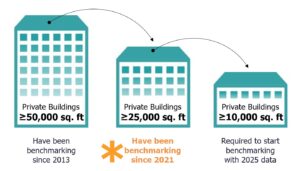Updated: February 2025 to reflect pending legislative changes due to the BEPS Amendment Act of 2024.
Introduction
Energy benchmarking means tracking a building’s energy and water use and using a standard metric to compare the building’s performance against past performance and to its peers both locally and nationwide. These comparisons have been shown to drive energy efficiency upgrades and increase occupancy rates and property values.
The DC Department of Energy & Environment (DOEE) published the final Benchmarking rules on October 22, 2021.
What is energy benchmarking?
Energy benchmarking is a valuable process for both building owners and occupants to better understand and quantify how their buildings are using resources such as energy and water. It can be used to compare energy and cost performance year-over-year, compare to similar buildings, and to better identify when a property is underperforming.
Each year, the District of Columbia collects and publishes detailed energy and water performance data from the largest buildings in the city. Additionally, the District’s Building Energy Performance Standards (BEPS) use energy benchmarking data as a baseline and establish minimum energy performance thresholds. Benchmarking is essential in identifying the level of action potentially required under BEPS.
Reviewing your benchmarking data, after ensuring its accuracy, will allow you to understand where there is opportunity to improve performance.
Building owners or their designees are periodically required to perform third-party verifications of their benchmarking data and submit the verification with their benchmarking reports. The first deadline for third-party verification was on July 1, 2024. The next third-party verification deadline is May 1, 2027 for calendar year 2026 data, and then the requirement will apply every six (6) years thereafter.
The Hub has created a sample scope of work (SOW) and companion how-to-guide to help make it easier to navigate the process.
Who is required to do this?
Starting in 2013, owners of privately-owned buildings larger than 50,000 sq. ft. have been annually benchmarking their energy and water efficiency and report the results to DOEE for public disclosure.
Starting in 2021, owners of privately-owned buildings larger than 25,000 sq. ft. were required to annually benchmark their energy and water performance and report the results to DOEE for public disclosure.
Starting in 2025, owners of privately-owned buildings larger than 10,000 sq. ft. are required to annually benchmark their performance and report it to DOEE by May 1, 2026. See below for step-by-step guidance how to start this process
For all buildings, we recommend starting the process early to get ahead of the reporting deadline. This is an on-going, annual requirement for your building due on May 1 of each year.

How do you do this?
Building owners are required to track the energy and water usage for their building(s) using the US EPA’s ENERGY STAR® Portfolio Manager and report that data to DOEE on an annual basis.
What is the process?
Step 1. Create an account (or use an existing account) through ENERGY STAR Portfolio Manager and set up the property in Portfolio Manager.
Step 2. Identify the data necessary for benchmarking including Property Information (primary use, square footage, year built) and Property Use Details (which depends on property type).
Step 3. Identify your DC Real Property Unique ID, which is usually your SSL/SSR
Step 4. Collect the necessary data including
- 12 months of base building energy data from Pepco (electricity) and Washington Gas (natural gas)
- Data from sub-metered, non-residential tenants
- Data from sub-metered residential tenants by using the utilities’ aggregated data tools
- Water data from DC Water
Step 5. Enroll in DOEE’s Automatic Annual Reporting to assist in the reporting and compliance process.
What resources are available?
Be sure to check out the many resources available on the Building Innovation Hub’s website, from DOEE, and from the U.S. EPA.
- ENERGY STAR Portfolio Manager offers multiple webinars and recorded videos that cover the basics of how to benchmark a building and use the Portfolio Manager tool. We recommend Portfolio Manager 101 for buildings that are benchmarking for the first time.
- DOEE has a number of helpful resources and DC-specific FAQs on their website.
- View the recorded webinars that go over how to submit your data to DOEE and how to benchmark multifamily buildings.
- Understand common errors In DC energy benchmarking to avoid mistakes in measuring your building’s energy performance.
- Review this guide to understand your energy benchmarking data and see where there is opportunity to improve your building’s performance.
- To help with Third-Party Benchmarking Data Verification (first required in 2024, not required again until 2027), the Hub has created a sample scope of work (SOW) and companion how-to-guide to help make it easier to navigate the process. See also a recording of the Best Practices webinar hosted by the Hub, and DOEE’s Third-Party Verification for Benchmarking FAQs.
Additionally, you can watch our DC Benchmarking 101 Webinar recording:
Who can you reach out to with questions?
Please contact DOEE by emailing them at building.performance@dc.gov or by visiting dc.beam-portal.org/helpdesk/.

